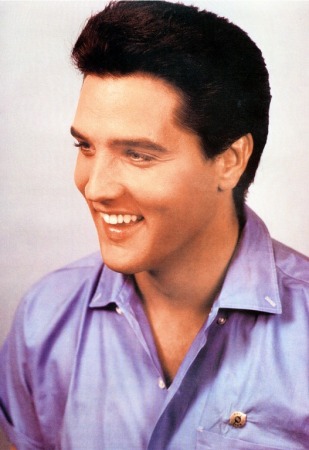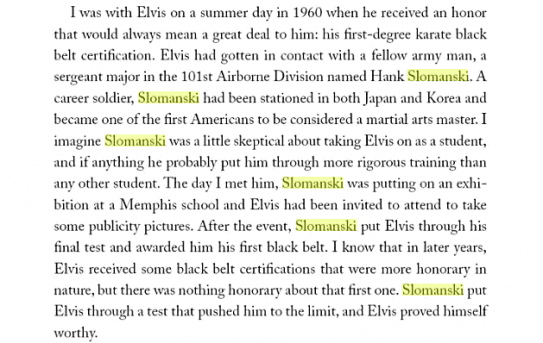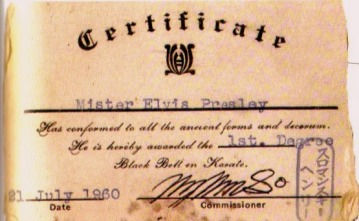Elvis Presley - Nidan
Ralph Jones – a member of the elite (Special Forces in the United States Army, had Command Sgt. Major Henry Slomanski as his instructor for airborne school) relates his eye witness account to Soke Burkhardt “. . . I was there when Presley was awarded his black belt from Slomanski and his instructors. They took him into the gym and locked the door. He was in the gym for over 2 hours and you could hear the thumps outside the building. He surely earned his belt that day.”
Excerpts from Grand Master Al Tracy’s site that was for public view at one time, was Elvis Really A Black Belt. We thank Grand Master Tracy for the use of these excerpts.
“… He (Presley) qualified for 1st degree black belt in 1960 in Memphis with the late Hank Slomanski, a Chito-ryu stylist.
And poor Hank Slomanski didn’t even get a listing of his own. Instead his contribution is reduced to an incidental mention under a listing devoted to Elvis Presley.
Who was Hank Slomanski?
Aside from his role as Presley’s tutor, Hank Slomanski may well have been North America’s first authentic martial arts master.

Hank Slomanski was making martial arts history when there were no martial arts magazines around to record it — but you had to be a part of the military with access to the military publications to find out about him.
In 1958-59 he was given feature coverage in the military newspaper Stars and Stripes Pacific edition. (Since I was a “Korean Veteran” the military kept me on their mailing list for years afterwards, no doubt hoping I would re-enlist. I continued getting Stars and Stripes long after I had been discharged from four years of active duty in the Air Force.)
Even in the military, which is full of real heroes, Hank Slomanski was a living legend. Standing 6’3″ and weighing 225 pounds, he was a formidable fighting machine.
And let the record show that Hank loved a good fight. When he couldn’t find any two-legged opponents, he would climb into a ring and wrestle bears – an opportunity available to some of the more adventurous members of the military on overseas assignment at that time.
It was while he was overseas that Hank was introduced to Chito-Ryu, a Japanese style founded by Dr. Tsuyoshi Chitose. Basically, Chito-Ryu is a combination of Goju-Ryu and Shorin-Ryu karate.
When the Korean war ended Slomanski was rotated back to the U.S. (in the mid 1950’s) for his next tour of duty. He was attached to the airborne division at Ft. Campbell, Kentucky.
Among other things, he was Sergeant-Major and jump master. He also happened to be Dan Inosanto’s first martial arts instructor. This was long before Dan Inosanto went on to become Bruce Lee’s most recognizable Jeet Kune Do student and confidante. And yes, Dan remembers Hank Slomanski very well: “He was head honcho — he ran everything!”
Dan remembers Hank as “Mr. Airborne”. By 1960 Hank had over 1,200 jumps, all with full combat gear — many in full combat!
Almost all of Hank’s students were military, which meant they were airborne undergoing typical airborne training. They started the day at first light by running 10 miles, after which they were allowed a little time to recover from the dry heaves. That out of the way, they ran another ten miles with Hank leading the pack!
All before breakfast.
So began a typical day. At the end of it, if you were so inclined, you could study karate with the man who had been putting you through hell all day.
When you entered this dojo, you observed strict rules. Rule No. 1: Hank Slomanski was your Sensei, with the absolute authority the title implied. Rule No. 2: you wore a karate gi unless training outside, in which case you dressed in military gear.
In this way the dojo was a blend of two traditions: U.S. military and Japanese martial arts. Off the dojo floor in tradition military fashion Hank Slomanski saluted all offices: in the dojo, you called him sir and bowed to him! (General Thomas S. Porter, a judo black belt, would observe this same tradition when he incorporate judo for SAC (Strategic Air Command) personnel under his command).
Dan Inosanto, a fellow student when we both trained with Ed Parker, trained with Slomanski in 1959-1960 and, nearly 30 years later, remembers the experience vividly. Hank threw terror into everyone, he says. It wasn’t unusual for Dan to look at the man next to him and see him visibly trembling.
A typical training session at Hank Slomanski’s dojo (Fort Campbell Gym) would begin with back falls on the hardwood floors. Remember — these were airborne recruits, and the ability to roll and fall properly could be the difference between life and death on every jump in combat.
If you were “lucky” Hank would take you outside where you could do your falls on packed sand. Now the bad news: you did your forward rolls on gravel. Next came setups. The setups were done in rows so that Hank could “run the rows”, all 230 pounds of romping, stomping airborne sergeant springing from one tense stomach to the next and onward down the row — and back again. Indoors Hank did the run bare-footed. Outdoors, he wore combat “jump boots”.
With the warm-ups over, the “serious” karate workout began. This was the training of Soke Burkhardt as well.
Kick, punch, block — over and over again. And with that out of the way, the class got ready for what this particular mode of training was all about: Fighting!
There was no safety gear — no shin pads, cups or supporters. This was blood-and-guts fighting.
If you didn’t like Hank much, this was your chance to get even. You could “go for real”. But it was a two-way street: Hank was prepared to give as good as he got. There were no wimps, the wimps had been washed out a long time ago. Those that had survived were the best the army had. They were airborne.
By comparison, his karate classes made the airborne training seem like an afternoon tea. As Dan Inosanto recalls, “He ran the class just like boot camp and he liked to make contact. Until I studied other styles, this is what I thought Karate was.”
Over the years I have known a few of Hank’s students and they all had certain traits in common. They were all tough! At best, their katas were so-so or non-existent. And they all loved to fight!
Up to this point it sounds like we have just another tough soldier.
Now, as they say, for the rest of the story.
Hank Slomanski almost single-handedly changed the course of karate tournaments in Japan, and as would follow, the rest of the world.



